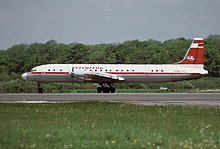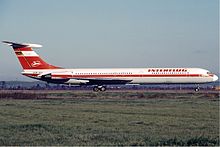Interflug
Following the end of World War II and the subsequent allied occupation of Germany, all aircraft in the country were seized and the airline was liquidated.
As a result, Interflug was set up on 18 September 1958 as a "backup" company, initially intended to complement the East German aviation industry by operating chartered flights.
Its staff, aircraft fleet, and route network were transferred to Interflug, which henceforth served as the East German flag carrier.
[1][2] As a state-owned airline, Interflug and its approximately 8,000 employees were under the control of the National Defense Council, in supreme command of the East German armed forces.
The majority of Interflug pilots were reserve officers of the National People's Army (and as such were required to be members of the Socialist Unity Party), and its aircraft could be requisitioned for military purposes at any time.
[4] Applicants for flight attendant jobs had to be approved of by the Stasi, which assessed their political reliability, in an attempt to minimize espionage and defection to Western countries.
[4] With some exceptions,[8] Western-built airliners (most notably those produced by Boeing, McDonnell Douglas, and Airbus) could not be delivered to Soviet bloc countries because of the CoCom embargo.
[9][10][11] The deal was secured with the support of Franz Josef Strauss, then Minister-President of Bavaria, chairman of the Airbus supervisory board and responsible for West German loans to East Germany.
[4] In early March 1990, Lufthansa signed a letter of intent to acquire 26 percent of Interflug,[13] but the offer was blocked by Germany's Federal Cartel Office.
For most of its existence, Interflug was not a member of the International Air Transport Association (IATA), and could therefore significantly undercut the ticket prices of other European carriers.
[28] From the 1970s, more effort was put into operating chartered flights to Mediterranean and Black Sea holiday resorts, many of which specifically catered to West Germans.
To simplify the transfer of passengers from West Berlin to and from Schönefeld Airport, a dedicated border crossing checkpoint was inaugurated at Waltersdorfer Chaussee, and scheduled shuttle buses were operated from the Central Bus Terminal in the Westend locality.
Pilots at Pan Am, which had a hub at Tegel, reportedly considered operating flights to Greece without pay to allow the airline to compete with Interflug.







